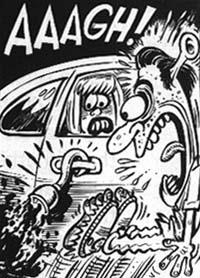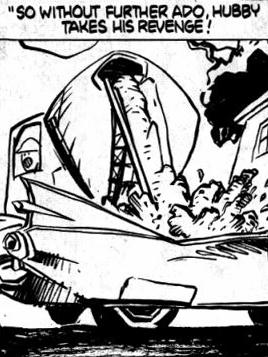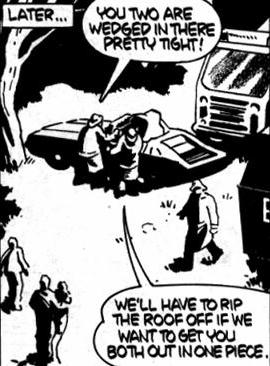|

Narrative Logo - Click for Main Menu
XI. The Urban Streets
be sure to see: The
Hottest 25 Urban Legends from Snopes

Caption: Legend lore, The Cayman in Newport
Beach, the $500 Rolls Royce
Many people see the hidden dreams and desires of a
culture, and its secret fears, reflected in the Urban Legend. A very interesting
manifestation of the Urban Legend is occurring on the web, right now, with the circulation
of jokes, riddles, and even virus warnings.
The Urban
Legend King
Jan Harold Brunvand is the King of the Urban Legend. He
teaches at the University of Utah, alive and well, and is still collecting all the stories
that you heard from a friend of a friend - that are REALLY TRUE!
In The Vanishing Hitchhiker, he states
that urban legends are "realistic stories concerning recent
events (or alleged events) with an ironic or supernatural twist. They are an integral part
of white Anglo-American culture and are told and believed by some of the most
sophisticated 'folk' of modern society - young people, urbanites, and the well
educated. The storytellers assume that the true facts of each case lie just one or two
informants back down the line with a reliable witness, or in a news media report"
(Brunvand xi-xii).

Urban Legend Comic Book Cover
E-mail: jan.brunvand@m.cc.utah.edu
Publications:
The Vanishing Hitchhiker: American Urban
Legends & Their Meanings (1981)
The Choking Doberman & Other "New" Urban
Legends (1984)
The Mexican Pet: More "New" Urban Legends &
Some Old Favorites (1986)
Curses! Broiled Again!, the Hottest Urban Legends
Going (1989)
The Baby Train: And Other Lusty Urban Legends
(1993)
American Folklore: An Encyclopedia. 1996
The Study of American Folklore, 4th edition. 1998
Too Good to be True: The Colossal Book of Urban
Legends (1999)
The Truth Never Stands in the Way of a Good
Story (2000)
Awards/Recognitions:
1956-57: Fulbright Scholar in Norway
1970-71: Guggenheim Fellow
1973-74 and 1981: IREX Fellowships in Romania

Caption: Cover from The Choking Doberman
Far from being hidden or 'dying', folklore thrives in public and private
spheres, both in everyday life and in extraordinary situations. We have explored spaces,
times, and groups in which folklore materials can be observed. Individual and communal
creativity,
as well as continuity and change will emerge as important concepts as we look at the ways
in which people communicate with each other not only through narratives, proverbs,
sermons, and jokes but also through displays of the body, of house and street, the
exchange of food, and the performance of music and dance during festivals and processions.
The incorporation of folklore in tourist attractions, school education programs,
government projects, advertisement and museums calls for a re-examination of the values
and meaning of folklore in contemporary society, especially in a world that is celebrating
globalization and is concerned with multiculturalism and identity politics.
I happen to have written a piece on Urban Legends that was
published both in
the print version and on-line in the very early editions of Orange Coast Magazine.
You can see it here: The $5000 Rolls Royce.
A story told at a Tustin dinner party about a friend of a
friend went like this: An Orange County couple had taken mother to Las Vegas. Mid-evening,
the couple tired of gambling and decided to go up to their room. Mother, however, was
winning and stayed at the slot machines.
She grew luckier yet as the night wore on, and, when she finally quit, she had two buckets
of silver dollars. She didn't think to cash them in; she just hurried to the elevator. On
the elevator were three black men. What with her buckets, and the fact that the two on the
outside were huge, when the door slid shut, she became frightened. She stood trembling,
praying for the door to open again.
Suddenly, the man in the middle yelled, "Hit the floor." And mother did just
that, splaying both herself and her cash across the floor. The man laughed heartily,
helped her gently to her feet, picked up her silver, pushed the button for her floor, and
kindly escorted her to her room. Amid apologies, the man slipped twenty thousand dollars
and a business card into the bucket. Mother was flustered, but let them go, intending to
return the money the next morning.
At the check-out desk, the next morning, the clerk was expecting her. He said that their
rooms had been paid in full by Eddie Murphy, who left a message saying that, while he was
sorry for the inconvenience, he had been much entertained by his little practical joke.

Caption: Cover from Brunvand's The Vanishing
Hitchhiker
What we have here is an urban legend, updated to include the
most likely celebrity, a nearby town, an amount of money sufficient to elicit a nod of
attention in Orange County circles. In fact, all the hallmark features of the urban legend
are present. It happened to a friend of a friend (FOAF), it has a rich oral tradition, it
appeals to our unconscious hopes and fears, and it shimmers with enough truth around the
edges to be almost believable--one more time.
When I ventured to mumble that this was a wonderful urban legend, my dinner companion
looked hurt. Perhaps another classic characteristic of urban folklore is that the teller
fervently believes it to be true. And perhaps it was. Maybe Eddie Murphy knew the story
and enjoyed updating it, because a similar tale has been in circulation for some time,
according to urban legend expert, Jan Harold Brunvand, a Professor of English at the
University of Utah.
In The Baby Train, one of five books that chart the
labyrinthine progress of familiar legends around the country--Brunvand cites a rich
history for "The Elevator Incident."
The genesis of the story seems to be this stock version: a black man on the elevator is
mistaken for a mugger but turns out to be Reggie Jackson. The man says "Sit" to
his dog, but the three women believe he is ordering them to submit to robbery, so they sit
on the floor. As the tale evolved, gathering embellishments, some maintained it was Jesse
Jackson, others preferred Michael Jackson. Brunvand asserts, "Soon other storytellers
were inserting different black personalities' names into the story, including Eddie Murphy
and Lionel Ritchie....even Lionel Hampton, the octogenarian jazzman." In fact, the
story is so ubiquitous that it rates its own category in Brunvand's Type-Index of Urban
Legends: "Type--Celebrity Rumors and Legends; Sub category, `The Elevator
Incident.'"
After listening to the Tustin variation, I set to wondering if Orange County has its own,
identifiable versions of urban legends. Like all forms of folk material, over time, urban
legends, (or asmuts, dead catters, and monkey sandwiches as they are also known), undergo
constant change from region to region.
The classic is the "alligator in the New York sewer
system." For the myth to work its magic you need a likely source for the alligator
(the child returning with a "pet" from Florida that is then flushed down the
toilet) and an accessible sewer. Had the "alligator" story migrated west? Sure
enough, it had. Several Irvine residents assured me that a FOAF had discovered an
alligator in Woodbridge Lake. It seems that a child that went to Disney World in Florida
and brought home a small amphibian that grew too large for the back yard pond.
The best variation, though, indicating that Southern Californians are inventive
legend-shapers, was the reputed Caiman in Back Bay.
We can speculate that an ordinary alligator wouldn't please Newport Beach folks, who
claimed an exotic, endangered species--from a trendy vacation spot like the Cayman
Islands.
Urban legends are a quirky subdivision of folklore. They may
not be strictly "urban" - they can take place anywhere - nor are they necessarily
American. Broadly speaking, they are contemporary anecdotes or beliefs that are born in a
particular era, are repeated, spread, change, and eventually disappear. Very broadly
speaking, they may even be true.
If urban legends tell us about human nature in general, the way the story is configured
reveals even more. The exemplary incidents we tell ourselves in Orange County bear this
out. Some tales have disappeared altogether from Southern California lore. One popular
fright of the `fifties concerned a beehive hairdo. We all knew the story of the girl who
keeled over in English class. When she was taken to the school nurse, it turned out she
had a "nest of black widows" in her ratted hair. Hair styles have changed, and
personal hygiene is valued; the "spider in the hairdo" is no longer palatable or
credible and so has fallen from circulation.
Other stories survive hereabouts through clever changes of
venue and detail. Consider the thirty-year-old classic, the "hook on the door
handle." It starts with a guy and his girl parked at "lover's lane." (You
can specify the old Back Bay Road in Orange County, Mulholland Drive in L.A., Panoramic in
Berkeley, etc.)
The radio is on. The announcer warns of an escaped maniac with a hook. Terrified, the boy
starts the car and quickly speeds away. When he gets to the girl's house, he comes around
to open the car door and finds--a bloody hook hanging from the door handle.

Caption: Cartoon of The Hook on the Door Handle
Classic Legend: A couple's late night make-out
session is cut short when they hear a report on the car radio about an escaped killer (who
has a hook for a hand) in the vicinity. The girl insists on being driven home immediately;
upon arrival at her house, the boy discovers a bloody hook hanging from the
passenger-side car door handle.
Baker, 1982] variation
This young couple is out parked on a country road. The girl is real nervous and uneasy. It
seems that there had been a report about an escaped criminal in the area. He was supposed
to be dangerous, a mad killer. They called him "The Hook" because one of his
hands was missing and he wore a hook in place of it. He was supposed to have used it on
all of his victims. Anyway, the girl was real uneasy for some reason. Supposedly, they
were not aware of the escaped killer. She kept saying she had an uneasy feeling but she
did not know why. The guy finally got mad at her. He thought she was just making up
excuses because she didn't want to park. Finally he lost his temper and stepped on the
gas. He really tore out of there fast. He didn't say a word on the way home. When they get
to the girl's house, he just got out and went around to open her door. When he got to the
door, there was a hook hanging on
the handle.
Origins: According to popular lore, bloody hooks have been left hanging on car doors
since the mid-1950s. It's possible the roots of legends like The Hook and The Boyfriend's
Death lie in distorted memories of real life Lover's Lane murders. There were actual cases
of kids who'd gone necking coming
back in pine boxes. The residue of news stories about those events would likely remain
around for a while, mutating into cautionary tales with the addition of bloody hooks and
scraping sounds on the roof of the car. (Click here for a fine writeup of a series of
Lovers Lane murders that happened in
Texarkana in 1946.)
Real life roots or not, The Hook has been a legend for almost as
long as anyone can remember.
Analysis: The key to this legend is the boyfriend's frustrated response to the girl's
demand to end the date abruptly. Almost invariably, he is said to have gunned the engine
and roared away. This behavior is essential to explain how the hook became ripped from
the killer's arm, and to underscore the moral of the tale. The boyfriend's frustration
stems from sexual denial. His girlfriend's insistence on getting home right away puts the
kibosh to any randy thoughts he'd been hoping to turn into reality that night, and he's
some pissed about it.
"The Hook" is a cautionary tale about teenage sexuality. Unspoken in the story
is the realization that if the girl hadn't said no, hadn't insisted upon leaving right
away, the couple would have been killed. Two close calls are averted that night: the fatal
encounter with the killer, and "going all the way." Refusal to do one saves the
pair from the other.
Urban legends are often little morality plays designed to instill an important lesson
about societal mores. "The Hook" is clearly one such tale, and its message is
clear: teens shouldn't have sex. Moreover, it's up to the girl to apply the brakes. Though
her boyfriend might be upset at the time, not long after he'll understand the wisdom of
her refusal and thank her for it. Or at least so says the legend.
Barbara "no nooky, no hooky" Mikkelson
Sightings: Look for this tale in the 1972 M.E. Keer novel Dinky Hocker Shoots
Smack! and in Stephen King's 1981 Danse Macabre. You'll also find mentions
of it in the 1979 comedy Meatballs, the 1992 film Candyman, the 1997 slasher
classic I Know What You Did Last Summer, and 1998's Urban Legend.
The URL for this page is http://www.snopes.com/horrors/madmen/hook.htm
Please use this URL in all links or references to this page
Click here to e-mail this page to a friend
Urban Legends Reference Pages © 1995-2000 by Barbara and David P. Mikkelson
Some problematic stuff in this version. First, they wouldn't be listening to the
radio - CD's are the thing. Second, hooks are rarer these days. Next, new doors don't have
open handles - even if a young gentleman should choose to open the door. But we adapt.
I
heard a FOAF tell of a Dana Hills High School couple on a camping trip to Joshua Tree.
They decided to take a moonlight hike. When they returned to the Jeep Cherokee a few hours
later, they found the windows smashed, their sleeping
bags slashed, and a grimy prison work shirt hanging over the tailgate. The boy's clothes
were gone.
This story is updated in predictable ways, but it has a distinct O.C. fingerprint, as
well. If you notice, the horror does not attach to the remains of the "maniac"
so much as the destruction of valuable property.
A corollary feature of Orange County tales: the price
escalates, especially in car stories. Brunvand lists five different legends under
"Legends about Automobiles; Sub Category, Cheap Car Fantasies." A favorite is
"`The $50 Porsche' - Husband's expensive car sold cheaply by abandoned wife."
In O.C. this story morphs quickly to include a real luxury car and other appropriate
details. It goes like this: A couple in Newport Beach was enduring a bitter divorce. The
husband was attempting to undervalue his net worth to reduce the settlement. While on a
"business" trip to Singapore (with his young paramour), he found he needed to
cover some derivatives. He called his wife and asked her to sell the Rolls and wire the
money to his broker.

Caption: Cartoon of Cement truck dumping cement onto the
Cadillac
a related story is "The Cement
Cadillac"
She did. She sold it for $500.00. Not only is the car upgraded, but the narrative is
embroidered with telling bits. In other parts of the country, you might hear a callous
disregard for the husband's destination, the reason for his request, but our tales set a
high standard for tightness, critical details, overall verisimilitude.
Timeliness, too, can be important to the success of the legend. The Northridge
earthquake gave rise to this one: A man in Huntington Harbor woke up on the morning of the
earthquake to find his BMW missing.
He reported the car stolen. Police returned it a couple of days later, marred only by a
bent fender and blood on the leather. It seemed the thief had crashed it on the Santa
Monica Freeway when the tremor struck. We know this is an urban legend because it was born
in the Oakland quake.
A man watching the World Series at Candlestick Park came out to find his car missing. Days
later, the police brought him only a crumpled license plate--the car, with thief, had been
crushed on the Bay Bridge when it collapsed.
That one turned up in slightly altered versions in San Francisco,
Modesto, and Fresno. Doubtless, the "Car Theft During the Earthquake" is
circulating in Japan now. Cars, celebs, terrors, and technology.
It was California that started the world wondering if coating the
thin, outer edge of a CD with green marking pen would enhance the sound. And,
technology also assists the spread of stories.
Lately, the chat has drifted away from the "real story of the O.J. Simpson
glove" and the "flesh-eating disease" to surgical mistakes, termite farts
destroying the atmosphere, the family who discovered a porno flick at the end of a rented
video of "Ace Ventura, Pet Detective", workers buried in the cement of bridge
pilings (reminiscent of the Hoover Dam rumors), children whose intestines have been sucked
out by pool drains, and the Nordstrom refund story. The strangest new tale is about the
local
French teacher who was knocked senseless when a chunk of "blue ice" fell through
the roof of the schoolroom. It seems the airlines freeze their sewage in flight and drop
it out....
Well, some of them could be true. Meanwhile, back in the cyberspace that is home, we
continue to improve the stories - more money, better brands, believable details.
Reliable FOAF's are telling of the second-tier County employee who left the U.S. for his
villa in Antigua in his private Cessna, toting his Cayman Islands bank book (yes!).
All
these, "gifts" of unsuspecting bankruptcy-pool participants. Supposedly, he had
managed to place a small, private endowment with Citron's County Pool.
Then, in the
confusion of early November, with a few false documents, he withdrew $40 million in cash.
As this unique O.C. legend ripens, we can expect the villa to be furnished, the plane to
transform into a Lear Jet, the millions to multiply, and the financial details to wax more
arcane--perhaps they already have.
Here's another favorite:

Caption: Cartoon of Couple wedged in the sports car,
rescue truck, etc.
Legend: An adulterous couple trysting in a
sports car becomes trapped inside
the automobile (and each other) and has to be cut out by the fire department.
LOVERS CUT FREE FROM EMBRACE
LONDON -- A tiny sports car leaves a lot to be desired as a midnight trysting spot, two
secret lovers have learned.
Wedged into a two-seater, a near-naked man was suddenly
immobilized by a slipped disc, trapping his
woman companion beneath him, according to a doctor writing in a medical journal here.
The desperate woman tried to summon help by honking the horn with her foot. A doctor,
ambulance driver, firemen, and a group of interested passersby quickly surrounded the car
in Regent's Park.
"The lady found herself trapped beneath 200 pounds of pain-racked, immobile
man," said Dr. Brian Richards of Kent.
"To free the couple, fireman had to cut away the car frame," he said.
The distraught woman, helped out of the car and into a coat, sobbed: "How am I going
to explain to my husband what has happened to his car?"
Variations:
The reason why the couple becomes stuck in the car varies: They simply become wedged into
a space too small to free themselves. The man (who is on top) injures his back and is
unable to move.
Freezing weather immobilizes them. The effects of alcohol or carbon monoxide fumes render
the lovers
incapable of freeing themselves. The woman is startled (generally by the approach of
someone else),
resulting in a case of penis captivus.
Sometimes one (or both) of the participants is a well-known community member.
Origins: The story is told both as a joke and as a real occurrence, so this legend, like
many others, may have originated as a piece of humor that was later run as a
"true" news item by an unsuspecting newspaper. It is a typical adultery legend
in which those who commit an infidelity are ultimately exposed by some accidental or
freakish occurrence. Some variations heighten the couple's humiliation (and possibly
increase the implied moral censure, since we hold persons of privilege to higher standards
than ourselves) by making one or both of them prominent people in their
community.
The punch line delivered by the woman in the final sentence has several
possible interpretations:
The wife is so amoral that the "wrongness" of her infidelity (especially in
light of her narrow escape) doesn't give her pause at all; she is solely concerned with
trying to explain away the evidence of it.
The wife considers her unfaithfulness to her husband to be a wrong of far lesser magnitude
than ruining his car.
The woman cares so little for her boyfriend that his well-being is much less important
than covering up their affair.
The wife realizes that it is the destruction of his precious car (and not her affair) that
will make her husband most angry; he values his automobile more than he values his spouse.
The example above was cited by Train as an actual [undated] Reuters article, with
a footnote indicating that the story was supposedly also covered by the London Sunday
Mirror.
Sightings: This legend was used as the plot of a 1985 British comedy film entitled
Car Trouble.
The URL for this page is <http://www.snopes.com/love/betrayal/stuckcpl.htm>
Please use this URL in all links or references to this page
Click here to e-mail this page to a friend [no longer available on
the WWW]
Urban Legends Reference Pages © 1995-2000 by Barbara and David P. Mikkelson
and, of course, the ill-fated
Birthday Party
Legend: A young man stops by his
fiancée's house while her parents are away;
the couple takes advantage of the empty house to engage in sexual play, only to
be caught in when the parents spring a surprise birthday on their daughter.
Examples: [Collected by Jansen, 1959]
There was a young couple of well-to-do
families who were engaged to be married. On the girl's birthday, the two of them went out,
but returned home rather early. Upon returning to the girl's home it was discovered that
the parents were away. The two of them decided to do something "different" and
removed all their clothing. Soon thereafter, the telephone rang. When she answered it, the
girl was asked by her mother to please go to the basement and turn off the automatic
washer, which she had forgotten. When the conversation ended, one of the couple decided it
would be fun if the boy carried the girl downstairs piggyback. This they proceeded to do,
and when they reached the bottom of the stairs, the lights came on and a large group of
friends and relatives yelled, "Surprise!" The girl, I was told, had a nervous
breakdown and was institutionalized. The boy has neither been seen nor heard of since.
In most versions the young man and woman are engaged, but some versions
describe them as a "recently married" couple. The surprise party is
usually arranged for the young woman's birthday, but versions involving a married couple
mention a party to celebrate the recent marriage.
The reason the couple goes downstairs to the basement (or down to the living room from an
upstairs bedroom) varies: a telephone call from the girl's mother asks her to perform some
task (usually involving laundry) in the basement; the couple goes down to the basement to
look at their wedding gifts, the couple (while upstairs in the bedroom) hears noises
coming from the living room and goes down to investigate, or the couple walks downstairs
to answer the phone. In some versions (such as the second
example above), the guests burst in on the couple through the front door.
The party is generally a complete surprise to the couple, but in early versions of the
legend it is arranged by the boyfriend.
In most versions involving a descent to the basement, the boyfriend carries his fiancée
downstairs in some manner: riding piggyback, carried in his arms, or perched on his
shoulders
The legend always ends with the engagement being broken off. Additionally, the woman
usually suffers a nervous breakdown (and is often institutionalized); in many versions the
boyfriend disappears, never to be seen again.
Origins: This example is one of two common versions of the "Surprise Party"
tale: a legend in which sexual misbehavior is accidentally discovered (and
"punished") during the course of a well-intentioned surprise. This legend dates
to at least the 1920s and in this form involves a couple whose engagement ends tragically
when they are caught indulging (or about to indulge) in premarital sex. Sexual activity
prior to marriage was still strongly taboo when this legend originated, and the offending
youngsters are punished with permanent separation. Versions of this legend involving a
married couple are mere
embarrassment tales with no moral point and may be corrupted versions of the original.
In a 1964 book of reminiscences, Hollywood publicist Art Moyer recounts an incident of
being invited to a surprise birthday party for an unnamed actress "only a few years
ago." According to Moyer, after the creme de la creme of Tinseltown was gathered in
the girl's foyer, her boyfriend called her to come
down from the second floor, promising a surprise. But it was the boyfriend (and the
guests) who got the surprise when she came sliding down the banister in the nude.
Given the lack of details provided in the tale, it's impossible now to determine if the
"sliding naked actress" story really did happen. It should be pointed out,
however, that elsewhere in the autobiography, Moyer carefully distinguishes between events
he was present for and bits of lore he heard told as true tales.
Analysis: The sexual activity is in this legend always described as being initiated by the
woman or by mutual consent; there is never the implication that the boyfriend has coerced
or pressured his girlfriend into having sex with him. Perhaps because the girl's
willingness to "sin" is seen as being greater than her
fiancé's (good girls should know better, after all), she suffers a far worse fate (mental
breakdown) than her boyfriend. The presence of church leaders or members (as well as
parents) at the denouement emphasizes the conflict between the religious values of the
older generation and the looser morality of
their children.
Sightings: A 1999 television commercial for Michelob Light featured a young woman who
discovers a note from her husband instructing her to grab a few beers and join him in the
living room. Figuring she knows what the invitation is for, she changes into sexy lingerie
before fetching the beer. When the living
room light snaps on to reveal family and friends, she's standing framed in the doorway in
her sexy nightie.
In November 1982 television's Newhart featured Bob' wife clad in a filmy negligee
descending the stairs to what she was going to be a romantic date by the fireplace with
her husband and what turned out to be a surprise party.
Last updated: 29 July 2000 / The URL for this page is http://www.snopes.com/sex/caught/surpart1.htm
Please use this URL in all links or references to this page
Urban Legends Reference Pages © 1995-2000 by Barbara and David P. Mikkelson
Continue
with Lecture XI.
|







